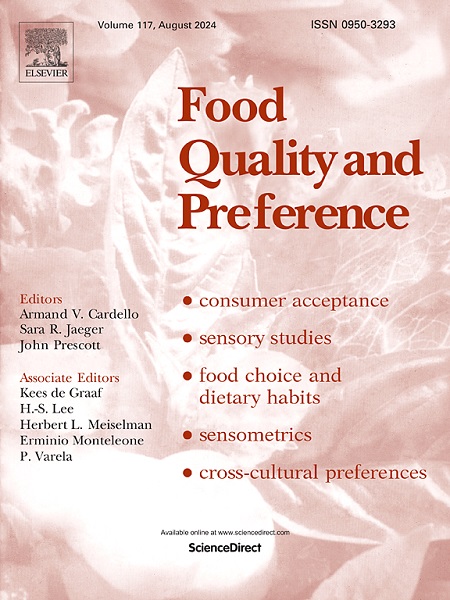Multisensory contextual cues and information affect plant-based food choices and taste perception
IF 4.9
1区 农林科学
Q1 FOOD SCIENCE & TECHNOLOGY
引用次数: 0
Abstract
The context in which food is selected and consumed is an important factor in its choice, consumption, and acceptability. This study assessed the effect of information and multisensory contexts on meat-related food choices and taste perception. In total, 224 participants first watched one of two pitches, either discussing the implications of consuming animal meat (sustainable pitch) or promoting body movement (control pitch). Participants were then exposed to one of three multisensory contexts: a ‘sustainable’ context with natural green colours, nature sounds and a flower fragrance, a ‘meat’ context with red colours, the sounds of country music and a smokey BBQ smell, and a monotone off-white ‘neutral’ context with neutral background music and no additional smell. Participants were instructed to choose one of two presented hotdogs (animal meat hotdog or plant-based meat hotdog) and to taste and rate the chosen one on liking and taste attributes. Results showed that multisensory sustainable contextual cues combined with information on sustainability beforehand increased the likelihood of choosing plant-based meat hotdogs over animal meat hotdogs. In addition, while tasting the plant-based meat hotdog, multisensory contextual cues that are inspired by a meat context appeared to enhance taste perception, even for vegans and vegetarians. These findings provide further evidence for the importance of context in food choice and acceptance: the context where people choose plant-based meat should preferably be separated and different from the context of consumption. The findings also imply that information can change behaviour, not just attitudes as previous research indicated, but only if combined with multisensory cues in the context.
求助全文
约1分钟内获得全文
求助全文
来源期刊

Food Quality and Preference
工程技术-食品科技
CiteScore
10.40
自引率
15.10%
发文量
263
审稿时长
38 days
期刊介绍:
Food Quality and Preference is a journal devoted to sensory, consumer and behavioural research in food and non-food products. It publishes original research, critical reviews, and short communications in sensory and consumer science, and sensometrics. In addition, the journal publishes special invited issues on important timely topics and from relevant conferences. These are aimed at bridging the gap between research and application, bringing together authors and readers in consumer and market research, sensory science, sensometrics and sensory evaluation, nutrition and food choice, as well as food research, product development and sensory quality assurance. Submissions to Food Quality and Preference are limited to papers that include some form of human measurement; papers that are limited to physical/chemical measures or the routine application of sensory, consumer or econometric analysis will not be considered unless they specifically make a novel scientific contribution in line with the journal''s coverage as outlined below.
 求助内容:
求助内容: 应助结果提醒方式:
应助结果提醒方式:


